Cite this document
(“Principles of Marketing Communications Essay Example | Topics and Well Written Essays - 2500 words”, n.d.)
Principles of Marketing Communications Essay Example | Topics and Well Written Essays - 2500 words. Retrieved from https://studentshare.org/marketing/1625239-principles-of-marketing-communications
Principles of Marketing Communications Essay Example | Topics and Well Written Essays - 2500 words. Retrieved from https://studentshare.org/marketing/1625239-principles-of-marketing-communications
(Principles of Marketing Communications Essay Example | Topics and Well Written Essays - 2500 Words)
Principles of Marketing Communications Essay Example | Topics and Well Written Essays - 2500 Words. https://studentshare.org/marketing/1625239-principles-of-marketing-communications.
Principles of Marketing Communications Essay Example | Topics and Well Written Essays - 2500 Words. https://studentshare.org/marketing/1625239-principles-of-marketing-communications.
“Principles of Marketing Communications Essay Example | Topics and Well Written Essays - 2500 Words”, n.d. https://studentshare.org/marketing/1625239-principles-of-marketing-communications.


